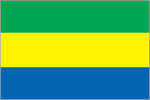Compare
Saint Helena, Ascension, and Tristan da Cunha
to
Gabonto
GabonThe life expectancy at birth in Gabon is 52.06 while in Saint Helena, Ascension, and Tristan da Cunha it is 79.21.
This entry contains the average number of years to be lived by a group of people born in the same year, if mortality at each age remains constant in the future. The entry includes total population as well as the male and female components. Life expectancy at birth is also a measure of overall quality of life in a country and summarizes the mortality at all ages. It can also be thought of as indicating the potential return on investment in human capital and is necessary for the calculation of various actuarial measures.
Source:
CIA World Factbook
The number of deaths of infants under one year old in a given year per 1,000 live births in Gabon is 47.03 while in Saint Helena, Ascension, and Tristan da Cunha it is 14.71.
This entry gives the number of deaths of infants under one year old in a given year per 1,000 live births in the same year; included is the total death rate, and deaths by sex, male and female. This rate is often used as an indicator of the level of health in a country.
Source:
CIA World Factbook
Gabon has an unemployment rate of 21.00% while Saint Helena, Ascension, and Tristan da Cunha has 14.00%
This entry contains the percent of the labor force that is without jobs.
Source:
CIA World Factbook
The GDP per capita in Gabon is $19,200 while in Saint Helena, Ascension, and Tristan da Cunha it is $7,800
This entry shows GDP on a purchasing power parity basis divided by population as of 1 July for the same year. A nation's GDP at purchasing power parity (PPP) exchange rates is the sum value of all goods and services produced in the country valued at prices prevailing in the United States. This is the measure most economists prefer when looking at per-capita welfare and when comparing living conditions or use of resources across countries. The measure is difficult to compute, as a US dollar value has to be assigned to all goods and services in the country regardless of whether these goods and services have a direct equivalent in the United States (for example, the value of an ox-cart or non-US military equipment); as a result, PPP estimates for some countries are based on a small and sometimes different set of goods and services. In addition, many countries do not formally participate in the World Bank's PPP project that calculates these measures, so the resulting GDP estimates for these countries may lack precision. For many developing countries, PPP-based GDP measures are multiples of the official exchange rate (OER) measure. The differences between the OER- and PPP-denominated GDP values for most of the wealthy industrialized countries are generally much smaller.
Source:
CIA World Factbook
Saint Helena, Ascension, and Tristan da Cunha consumes 0.5418 gallons of oil per day per capita while Gabon consumes 0.3948
This entry is the total oil consumed in gallons per day (gal/day) divided by the population. The discrepancy between the amount of oil produced and/or imported and the amount consumed and/or exported is due to the omission of stock changes, refinery gains, and other complicating factors.
Source:
CIA World Factbook
The per capita consumption of electricity in Saint Helena, Ascension, and Tristan da Cunha is 956kWh while in Gabon it is 862kWh
This entry consists of total electricity generated annually plus imports and minus exports, expressed in kilowatt-hours. The discrepancy between the amount of electricity generated and/or imported and the amount consumed and/or exported is accounted for as loss in transmission and distribution.
Source:
CIA World Factbook
The annual number of births per 1,000 people in Gabon is 34.64 while in Saint Helena, Ascension, and Tristan da Cunha it is 10.03.
This entry gives the average annual number of births during a year per 1,000 persons in the population at midyear; also known as crude birth rate. The birth rate is usually the dominant factor in determining the rate of population growth. It depends on both the level of fertility and the age structure of the population.
Source:
CIA World Factbook
 With its 1,672,597 people, Gabon is the
151st largest country in the world by
population. It is the 77th largest country in the
world by area with 267,667 square kilometers.
With its 1,672,597 people, Gabon is the
151st largest country in the world by
population. It is the 77th largest country in the
world by area with 267,667 square kilometers.
El Hadj Omar BONGO Ondimba - one of the longest-serving heads of state in the world - dominated the country's political scene for four decades (1967-2009) following independence from France in 1960. President BONGO introduced a nominal multiparty system and a new constitution in the early 1990s. However, allegations of electoral fraud during local elections in December 2002 and the presidential elections in 2005 exposed the weaknesses of formal political structures in Gabon. Following President BONGO's death in 2009, new elections brought Ali BONGO Ondimba, son of the former president, to power. Despite constrained political conditions, Gabon's small population, abundant natural resources, and considerable foreign support have helped make it one of the more stable African countries.
Check out the recommended reading list below for great sources of information on Gabon